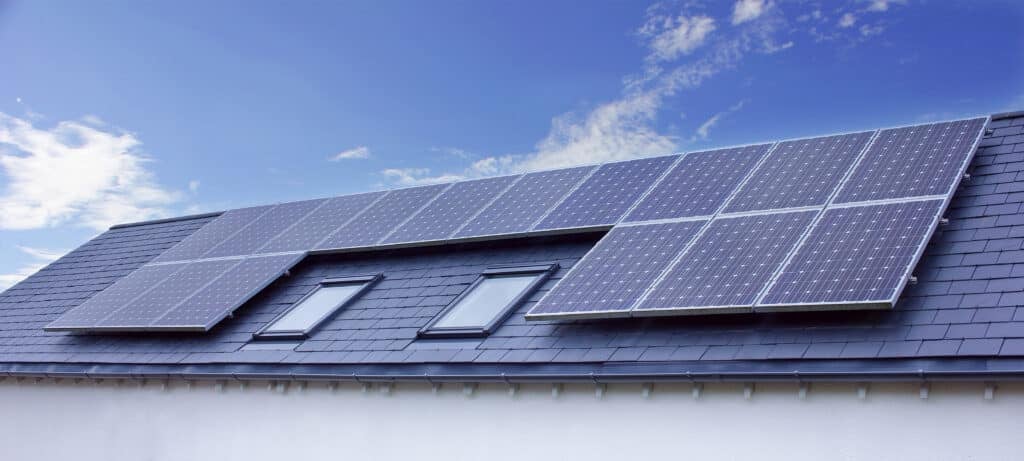There are multiple options for using solar energy to power or light your home. We outline some of the most common uses of solar energy for homes below.
Solar Panel Systems
Installing a solar power system is the most effective way to power your entire home using solar energy. The best solar panels can last more than 25 years, providing your home with clean energy and utility bill savings for decades. However, solar panel systems include a high upfront cost.
According to our March 2023 survey of 1,000 homeowners with solar, it costs $2.85 per watt on average to install a solar panel system. Based on this figure, you could expect to pay around $14,250 for a 5 kilowatt (kW) system or $28,500 for a 10 kW system. In both cases, you can claim solar incentives like the solar Investment Tax Credit (ITC) to lower project costs.
If you’re considering solar energy but prefer to avoid a major investment, there are alternative technologies that come at a lower cost.
Solar Water Heaters
Solar water heaters use collector panels directly exposed to the sun’s rays to generate hot water for your home. The solar collectors use a heat transfer fluid such as ethylene glycol to capture thermal energy, which is then used to heat water for residential use.
The price of solar water heaters can range from $1,500 to $13,000, depending on the size and complexity. Large solar water heaters compare to PV panels in terms of price, but small units are more affordable.
Generally, passive solar water heaters are more affordable than solar panel systems but have a longer payback period. According to a cost analysis by the U.S. Department of Energy, the payback period of solar water heaters can exceed 10 years.
In warm climates, a solar water heater can potentially cover 100% of your hot water needs. However, you may need an electric or gas-fired heating system as backup in colder locations.
Portable Solar Panel Kits
Solar energy systems are available in all sizes. You can invest in a large rooftop system to generate electricity for your entire home or you can use a portable solar kit to power small appliances.
Based on our research, there are portable solar generators with built-in batteries and power outlets priced below $2,000. Smaller systems cannot provide enough power for HVAC equipment or refrigerators, but you can connect small devices such as LED lights and smartphone chargers.
The large solar panels used for rooftop and ground-mount systems are designed for professional installation. Since portable solar kits have lower voltages and power ratings, they are suitable for DIY installations.
You can also use small solar panels to power outdoor sheds and light fixtures, instead of having to wire long circuits between your main panel and outdoor areas. Based on our market research, you can find outdoor solar lights with built-in PV panels and batteries below $100. There is a wide range of lighting products available, including solar security lights and rechargeable flashlights.
Skylights and Solar Tubes
Using solar energy is not limited to home heating and electric power generation. The sun is also a source of free natural lighting, which you can utilize inside your home. For example, you can install skylights or solar tubes to allow sunlight into your home while reducing solar heat gain. While LED bulbs consume up to 90% less electricity than traditional lamps, solar skylights have zero energy usage.
The cost of solar tubes and skylights varies depending on their design. You can find basic solar tubes with an installed cost of around $500, while large skylights can exceed $2,000.
Join a Community Solar Project
Some energy consumers may not have the option of installing solar panels, including renters without a private roof area or people without adequate roof space. In these cases, you can join a community solar project instead of purchasing your own panels.
Community solar systems are shared by many electricity consumers who participate as shareholders or subscribers. The electricity generated by a community solar project is measured and split among participants based on their ownership share or subscription to the project.
Community solar systems also offer mobility for renters. If you move to another address while subscribing to a community solar project, you can assign your solar energy credits to your new power bill. This method is much simpler than having to relocate a rooftop solar system.
However, community solar power is not available everywhere. Check with your state or local government to see if you have access to community solar projects in your area.
Switch to an Electricity Plan that Uses Renewable Energy
Depending on where you live, you may have the option of choosing your electricity provider. For example, Texas has a deregulated power sector in which consumers can choose an electricity plan. In this case, you can look for energy plans that use 100% renewable energy. However, this option is only available in certain regions of the U.S.
Read the full article here














